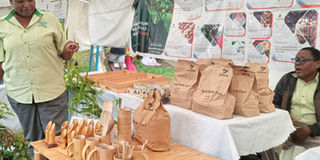Prime
Plant bamboo for more income

Scientists at NaFORRI display bamboo value-added products. Photo | Lominda Afedraru
What you need to know:
- It’s also a source of paper, packaging, furniture and fabrics materials. It can be used to produce biofuels, charcoal, crafts, mats, curtains, incest stick and skewers
Bamboo is considered extremely versatile plant because its sturdy, wood like nature makes it useful in construction.
It’s also a source of paper, packaging, furniture and fabrics materials. It can be used to produce biofuels, charcoal, crafts, mats, curtains, incest stick and skewers
Useful
Uganda has 55,000 hectares of bamboo grown across the country including species that can be used for everything from fodder to fuel and furniture.
Despite its high demand as construction material few farmers are growing it and the country is missing out on the global market worth $60b.
As such, scientists at the National Agricultural Forest Resources Research Institute (NaFORRI) have embarked on breeding various bamboo species for uptake for purposes of increasing the growing capacity.
The breeding initiative
Dr Juventine Odoi Boaz, who is leading the breeding team at NaFORRI, explains that the grass culms have for long been used as lawn plants, for making furniture and demarcating boundaries.
In bamboo, as in other grasses, the internodal regions of the stem are usually hollow and the vascular bundles in the cross section are scattered throughout the stem instead of in a cylindrical arrangement.
He notes that although there are about 1,640 bamboo species in the world, in Uganda, farmers are growing about three species. These include both highland species growing in the slopes of Mt Elgon and in the lowlands grown across the including central region and the West Nile region.
They include common bamboo, African alpine bamboo, whose shoots are eaten by people around Mt Elgon in Eastern Uganda and Giant Bamboo, which is ideal for constriction and wood.
Why breed bamboo
According to Odoi, his team embarked on breeding bamboo varieties after the Ministry of Science Technology and innovations approached them to breed the plant and distribute its plantlets to farmers so that there is enough supply being demanded by Kiira Motors in their Vehicle manufacturing.
There are also a number of companies that are demand bamboo use as water pipes and it’s the Institute mandate to ensure there is enough supply.
So far the team has done a collection of all the varieties which is being propagated at the institute but the major focus is on the giant bamboo variety for industrial manufacturing purpose. The team made cuttings and transplanted them for planting at the Institute. They have already distributed a number of the seedlings to farmers but at a fee.
Apparently they are also sensitizing farmers about the agronomy to ensure the right steps are followed to acquire the required yield.
Soil requirement
According to the scientists Bamboo does best in well-drained, moist, fertile loamy and sandy loamy soils. It will not however tolerate continuously swampy or waterlogged sites.
Propagation
The plant growth is through vegetative propagation.
Vegetative means such as use of transplants and rhizome cuttings are commonly used.
Farmers are advised to set up nursery beds for planting the seedlings by choosing a healthy bamboo stalk from an established plant.
This can be done through use of offsets and stem cuttings. For exotic species which require warm climatic conditions, the use of a green house is recommended, especially in cooler areas.
However, where there is no greenhouse, a locally assembled polyethylene tunnelling structure can be improvised.
Framers can count up to three rings, or nodes, from the bottom and cut the stalk free using a small saw.
The resulting middle section of the stalk will become the new plant.
Fill a high density polythene bag with the mixture of potting soil and sand and the farmers must be sure the pot has holes in the bottom to allow drainage.
Stem cuttings has several advantages including multiplication of many clumping species is possible by this method.
It is important to place buds at the nodes or branches sideways or facing upwards and never downwards for proper shoot formation. It will take three to four months in the nursery before transplanting.
Planting
Bamboo prefers loamy and sandy loamy soils, but what is more critical is good drainage since the crop cannot withstand water logging. Species such as Solid Bamboo and savannah bamboo are drought resistance and they withstand environments having annual rainfall of less than 800mm.
It is important to plan the field layout so that harvesting and hauling of culms is eased when the clumps have matured.
Spacing of small diameter plants is 3m x 3m but those giant species require 10m by 10m and plants per hectare should be reduced; wider spacing will allow the clumps to reach their full potential, especially when the objective of the plantation is to harvest bamboo timber.
As a general rule, improve the soil with compost or animal manure. It takes about three years for some species to be mature but species intended for water pipes and construction may take longer than that.
Weeding
Weeding and mulching in drier areas, with rainfall less than 800 mm has been found to boost growth through reduced evaporation of soil water.
Spot weeding rids the seedlings from competing with weeds. This should be done at a radius of 60cm around the seedlings after planting.
Pests and diseases
The plant suffers challenge of pests such as aphids described as small, light-green, pear-shaped bugs that feed on the underside of the leaves.
They cause yellowing, drop-off and mites which end up destroying the stalk but this can be controlled through spraying using the required pesticide.
Value addition
The institute the team is already making the above with the most outstanding product being cups and spoons.




